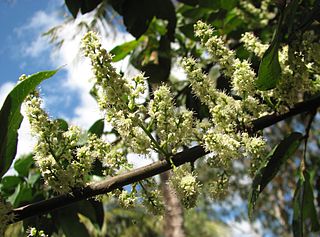
Alectryon is a genus of about 30 species of trees and shrubs from the family Sapindaceae. They grow naturally across Australasia, Papuasia, Melanesia, western Polynesia, east Malesia and Southeast Asia, including across mainland Australia, especially diverse in eastern Queensland and New South Wales, the Torres Strait Islands, New Guinea, the Solomon Islands, New Caledonia, New Zealand, Vanuatu, Fiji, Samoa, Hawaii, Indonesia and the Philippines. They grow in a wide variety of natural habitats, from rainforests, gallery forests and coastal forests to arid savannas and heaths.

Cupaniopsis is a genus of about 67 species of trees and shrubs of the soapberry family, Sapindaceae. They grow naturally in New Guinea, New Caledonia, Australia, Torres Strait Islands, Fiji, Samoa, Sulawesi, Micronesia. Many species have been threatened with extinction globally or nationally, with official recognition by the International Union for Conservation of Nature (IUCN) and several national and state governments.

Guioa is a genus of about 78 rainforest tree species known to science, which constitute part of the plant family Sapindaceae. They have a wide distribution, ranging from throughout Malesia, in Burma, Cambodia, Vietnam, Thailand, Malay Peninsula, Borneo, Sumatra, Philippines, Java, Flores, Timor, Sulawesi, Moluccas, New Guinea, further southwards through the east coast of Queensland and New South Wales, Australia and further eastwards to the Pacific Islands, including Tonga, New Caledonia, Fiji and Samoa.

Arytera is a genus of about twenty–eight species known to science, of trees and shrubs and constituting part of the plant family Sapindaceae. They grow naturally in New Guinea, Indonesia, New Caledonia, Australia, the Solomon Islands, Vanuatu, Fiji, Samoa, Tonga; and the most widespread species and type species A. littoralis grows throughout Malesia and across Southeast Asia, from NE. India, southern China, Borneo, Malaysia, Singapore, Indonesia and the Philippines to as far east as New Guinea and the Solomon Islands.

Elattostachys is a genus of about 21 species of trees known to science, constituting part of the plant family Sapindaceae.

Acropogon is a genus of flowering plants in the family Malvaceae. The genus is endemic to New Caledonia. It contains around 25 species. Its closest relatives are Australian genera: Argyrodendron, Brachychiton and Franciscodendron.

Bikkia is a genus of flowering plants in the family Rubiaceae. It is native to the Philippines, the Maluku region of eastern Indonesia, New Guinea and the western Pacific. The genus was named by Caspar Reinwardt in 1825. Seven of the New Caledonian species previously included in Bikkia were transferred to a separate genus, Thiollierea, in 2011 based on molecular and morphological information.

Dodonaeoideae is a subfamily of flowering plants in the soapberry family, Sapindaceae.

Sarcotoechia is a genus of tropical rainforest trees, constituting part of the plant family Sapindaceae.

Benstonea is a genus of flowering plants in the family Pandanaceae. It was formerly known as Acrostigma, a subgenus of Pandanus, but in 2012 was recognized as a distinct genus based on morphology and DNA sequencing. Benstonea is distributed from India to Fiji with centres of diversity in Borneo, Peninsular Malaysia and New Guinea.
Gongrodiscus is a genus of shrubs and trees in the family Sapindaceae. The genus is endemic to New Caledonia in the Pacific and contains three species. It is related to Sarcotoechia and Storthocalyx.
Podonephelium is a genus of shrubs and trees in the family Sapindaceae. The genus is endemic to New Caledonia in the Pacific and contains nine species. Its closest relative is Alectryon.
Storthocalyx is a genus of shrubs and trees in the family Sapindaceae. The genus is endemic to New Caledonia in the Pacific and contains five species. It is related to Gongrodiscus and Sarcotoechia.

Sapindoideae is a subfamily of flowering plants in the soapberry family, Sapindaceae. It includes a number of fruit trees, including lychees, longans, rambutans, and quenepas.
Gereaua is a monotypic genus of flowering plants belonging to the family Sapindaceae. It only contains one species, Gereaua perrieri.
Bathiorhamnus is a genus of flowering plants belonging to the family Rhamnaceae.
Colea is a genus of flowering plants belonging to the family Bignoniaceae.

Benstonea monticola, commonly known as scrub breadfruit or urchin-fruited pandan, is a plant in the family Pandanaceae which is endemic to rainforested parts of north east Queensland, Australia.
Neoarytera is a genus of flowering plants in family Sapindaceae. It includes four species native to New Caledonia and Vanuatu.











